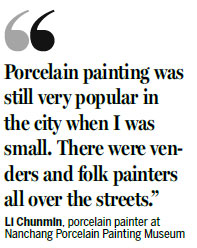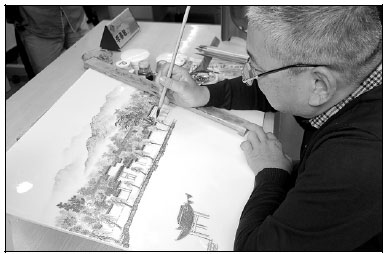Porcelain works glow in Nanchang museum
Updated: 2015-10-13 08:44
By Liu Xiangrui And Shi Xiaofeng In Nanchang(China Daily)
|
|||||||||||
While the exhibits at Nanchang Porcelain Painting Museum in suburban Nanchang in East China's Jiangxi province may impress each visitor with their elegance, they are also likely to evoke childhood memories among many visitors, especially the elderly.
The museum is dedicated to porcelain painting - a rare craft that was popular in Nanchang and its surrounding regions at one time.
The museum, with a floor space of nearly 10,000 square meters, was built with government funding and opened in 2013, aimed at integrating the exhibition, creation, research and collection of painted porcelain art, which was named by the Ministry of Culture as a national intangible cultural heritage in 2008.
Porcelain painting originated more than a century ago in the Nanchang region, where in the early days, rich people often invited painters to paint realistic portraits of their parents on square porcelain pieces so that they could hang them on the walls of their homes as a way of remembering the deceased.
Gradually, porcelain painting developed with a complete set of materials, techniques and representation forms for itself.
"Porcelain painting was still very popular in the city when I was small. There were venders and folk painters all over the streets," recalls Li Chunmin, 57. Li, who is now a well-known porcelain-painting artist, works at the museum. He started to learn the art when he was age 16.
"I was interested in painting since I was a child. I had disability in my legs, so my mother advised me to learn porcelain painting when she saw the folk painters do their work while sitting," he says.
While creating porcelain paintings, mineral pigments mixed with oil are applied on flat porcelain pieces. Each painting is composed of three or even more layers. Each time a new layer is applied, the whole piece is placed inside the furnace.
According to Li, a regular-sized portrait usually takes him more than 10 days to finish.
"It takes the experience of a painter to get the right colors, because changes in color usually occur after the furnace procedure," Li says. "The painters must have a clear idea of what they paint beforehand, as no white color is employed and he must leave out the white areas."
Since the 1990s, porcelain painting almost faded away from local people's life due to the fast development of photography and computer technologies.
In recent years, local government's support and craft's inheritors' innovation rejuvenated porcelain painting as a special modern art form, though its role as a pragmatic folk craft is outdated.

Modern day artists have not only broken the content limits and brought in diverse themes, but also combined the craft with artistic and daily porcelains to satisfy the public's needs.
In recent years, works by master porcelain painters such as Feng Jie often sell several million yuan at auctions. The artworks are also favored by international collectors.
The Research Center of Nanchang Porcelain Painting of the museum has made efforts to collect and promote the art through different measures, according to Xin Ying, the center director. "We are looking for true inheritors for the traditional culture," Xin says.
The center has established a long-term training program to cultivate professional porcelain painters. It has trained more than 40 painters since 2011, and many of the graduates have joined the center's several porcelain painting studios that focus on different categories.
Yu Ronghua, 33, one of the former trainees, has become a professional painter at the center after finishing the program and has now tutored three students himself.
"It takes about three years of training to become a qualified porcelain painter. It's hard as we don't have incomes during the time. But most of us have persevered," Yu says.
Besides, the center has carried out cooperation with a number of local primary schools to promote the art among the younger generation. Artists from the center will teach classes for students who are interested in the craft, Xin adds
liuxiangrui@chinadaily.com.cn
|
Li Chunmin demonstrates how to paint on a porcelain board at the museum.Shi Xiaofeng / China Daily |
(China Daily 10/13/2015 page20)
Today's Top News
Opinion: Opportunity knocks for EU and China over next five years
Yuan rises for 7th day in a row, highest level since August
Reforms spark legal brain drain
High-tech zones up the game
EU officials postpone visit to Turkey after attacks in Ankara
Documents of Nanjing Massacre inscribed on Memory of World Register
Xi congratulates Kim on WPK anniversary
CPC expels media exec over UK 'green card'
Hot Topics
Lunar probe , China growth forecasts, Emission rules get tougher, China seen through 'colored lens', International board,
Editor's Picks

|

|

|

|

|

|







